- Home
- INNOVATION
- Research Areas
- Skin Research
Skin Science
In more than 100 years of research and development, Shiseido has continued to face the eternal skin concerns of consumers, including sagging, wrinkles, spots, and dullness, while evolving the observation technology and worked towards the elucidation of contributing factors and development of solutions. In recent years, we focused on the conditions inside the skin, including blood vessels, lymph ducts, immunity, and nerves, and deepened the research in the relationship of these structures and the skin conditions.
Research on Skin Sagging
Shiseido has repeatedly elucidated findings regarding the age-related changes in facial contour, sagging, as a pioneer in this research area.
The results are evaluated highly in international research forums hosted by IFSCC*, including the receipt of conference awards four times in succession.
- *IFSCC:The International Federation of Societies of Cosmetic Chemists
Shiseido Discovers Skin’s Anti-gravity System ”Dynamic Belt”
We elucidated the cause of sagging for the aged appearance and discovered the Dynamic Belt, which is a system where the skin resists the deformation caused by gravity. The Dynamic Belt is a mechanism where the hair muscles on the face at high density resists gravity.

Aligned high-density arrector pili muscles
Research on Skin Wrinkles
We have closed in on the root cause of wrinkles and deepened the research on solution as pure retinol as the only retino-related substance in Japan with the indication of wrinkle improvement as Shiseido's representative technology in improving wrinkles.
Shiseido Discovers that Balance of Internal Skin Elasticity is Root Cause of Wrinkles
Using the independently developed cutting-edge technology for imaging skin elasticity in three dimensions, we analyzed the mechano-physical properties of skin for consumers in various age groups, from young to senior, and found that the “balance of elasticity between the stratum corneum and the dermis” deteriorates with age, concluding that such phenomenon is the root cause of wrinkle formation.
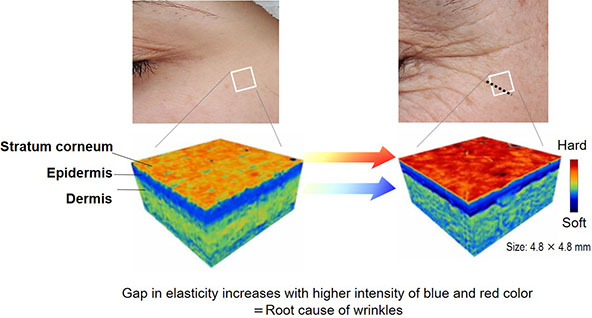
Occurrence of elasticity gap between stratum corneum and dermis
Research on Skin Pigmentation and Dullness
We closed in on the mechanisms of pigmentation and dullness and have worked to develop solution materials ranging from the independently developed brightening active ingredient potassium 4-methoxysalicylate and tranexamic acid to a variety of plant extracts.
Shiseido Reveals Part of Mechanism that Photoaging Induces Dull Skin via Cutting-Edge Epigenetics Research
We have elucidated part of the mechanism by which photoaging*1 and other factors induce acquired genetics (epigenetics) to make skin dull.
- *1Skin aging phenomena such as spots and wrinkles caused by UV rays in sunlight. It is considered to be a major cause of skin aging.
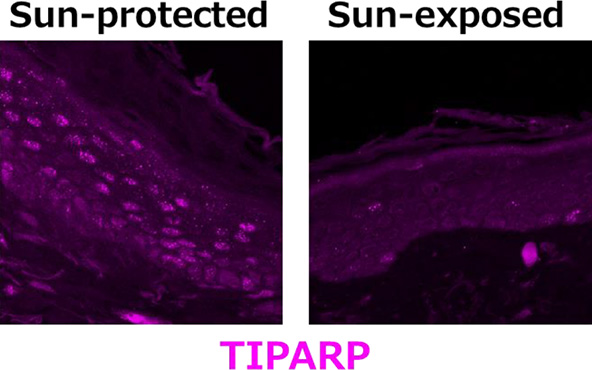
TIPARP expression is reduced at Sun--exposed area
Research on Skin Blood Vessels, lymph ducts, Immunity, and Nerves
We develop technology for non-invasive observation of the conditions of blood vessels, lymph ducts, immunity, and nerves that exists in the skin and play a role in linking the skin to the entire body, while also elucidating the relationship with the beauty of the skin.
Shiseido makes discovery of the effect of Fermented Camellia Seed Extract to promote the expression of a factor that recruits senescent cell-eliminating immune cells
We discovered for that Fermented Camellia Seed Extract can increase the expression of CXCL9, which potentially recruits the immune cells CD4 CTL(Memory T cells) having the function to eliminate senescent fibroblasts in the skin. In other words, Fermented Camellia Seed Extract is expected to enhance the effect of skin immune cells to eliminate senescent cells.
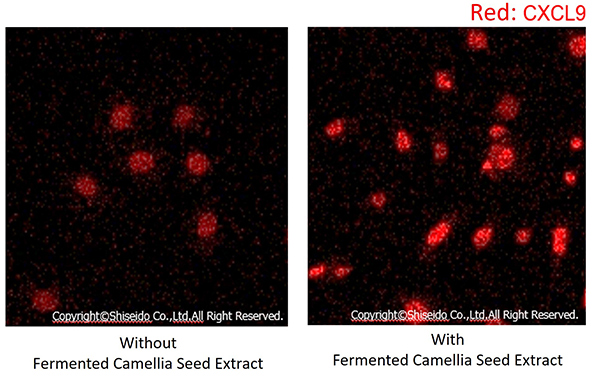
Fermented Camellia Seed Extract increases the level of CXCL9 expression
Research as a result of 30 years of collaboration between Shiseido and CBRC reveals a novel mechanism by which skin’s immune cells eliminate senescent cells
We discovered as a new function of skin’s immune cells the elimination of aged fibroblasts (senescent cells) and its mechanism. Advancing age alone does not correlate with the accumulation of senescent cells in the human skin. Among the potential mechanisms, Cytotoxic CD4+ T cell (CD4 CTL) , a type of immune cells, are strongly associated with the inhibition of accumulation of senescent cells.
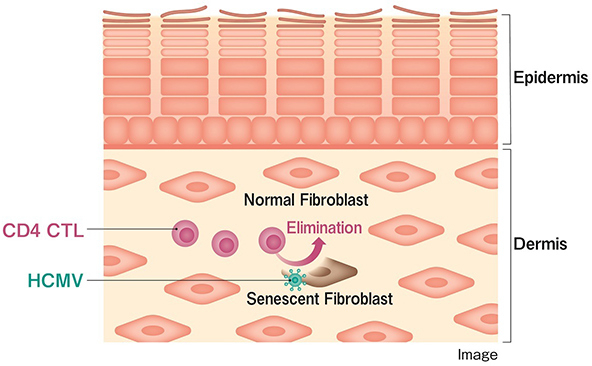
CD4 CTL eliminate senescent cells using HCMV as an antigen
Shiseido Elucidates Mechanism by Which Capillaries Maintain Skin Elasticity
We gained understanding of the mechanism in which capillaries contribute to skin elasticity, and identified that neem leaf extract and Houttuynia cordata extract work effectively for maintaining thick (large diameter) and stable capillaries, which can become thinner and regress due to aging and ultraviolet rays, etc.
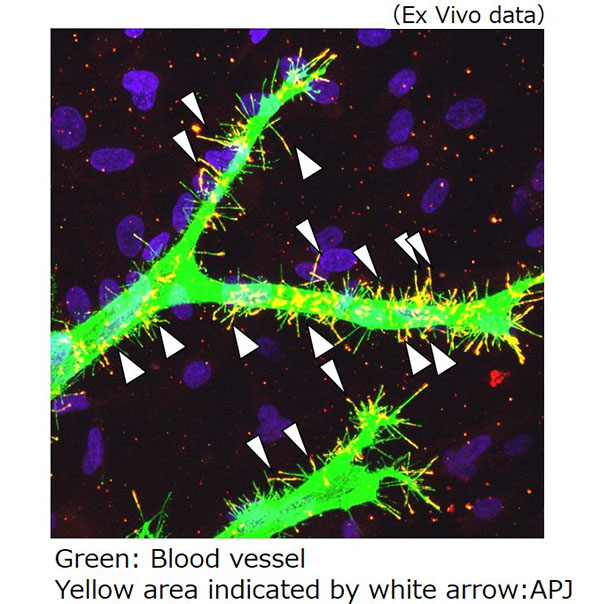
Softness sensor APJ in capillaries
Shiseido Reaches World’s First Elucidation of Aging Mechanism of Lymphatic Vessels in the Skin
We have elucidated the aging mechanism of lymphatic vessels in the skin for the first in the world by applying its unique skin visualization technology*1.
- *1Shiseido Establishes Lymphatic Vessel Visualization Technology (2020)
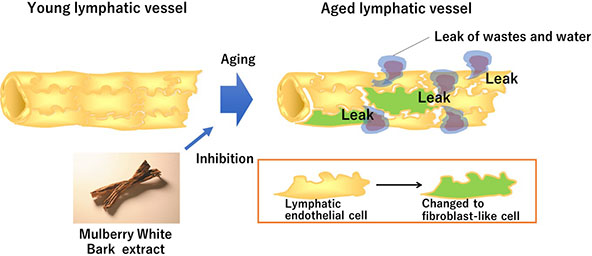
Overview of this research
Shiseido Reveals that Downregulation of Epidermal Keratinocyte-Derived IL-34 Skews Macrophage Balance
Our new discovery revealed that the downregulation of IL-34 (interleukin 34), a protein secreted in the epidermis, skews the M1/M2 balance, a balance between two types of macrophages (M1 macrophages and M2 macrophages), which has previously been found to be involved in skin aging and collagen metabolism.
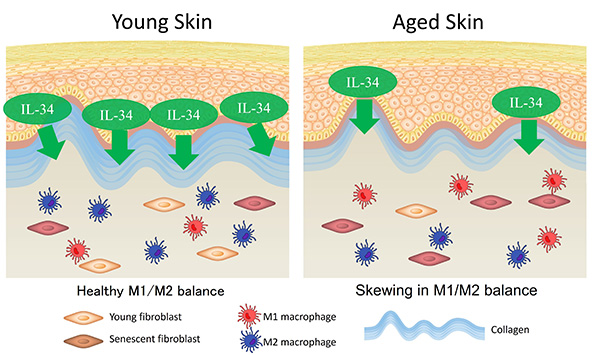
IL-34 downregulation skews macrophage balance.
Shiseido Discovers That Age-Induced Macrophage Imbalance Affects Collagen Metabolism
We revealed that the balance between two types of macrophages*1 (the M1/M2 balance) is involved in a series of collagen metabolism, collagen production, fragmentation, and degradation in photoaged skin.
- *1:A type of immune cell whose main function is to eliminate bacteria and waste products. M1 macrophages are mainly responsible for the inflammatory reaction and removing foreign materials, whereas M2 macrophages promote the anti-inflammatory reaction and repair of tissues damaged by inflammation.
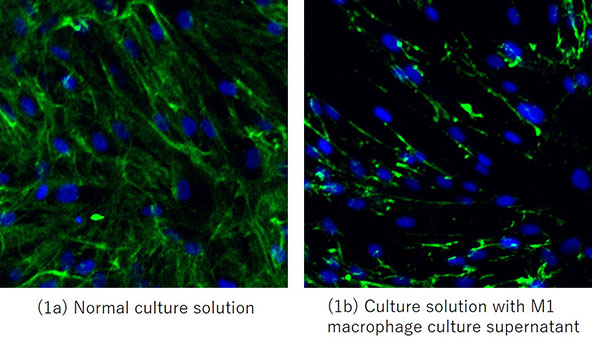
The effect of supernatant M1 macrophage culture on collagen fiber formation.
Shiseido Clarifies Underlying Mechanism of Age-Related Changes in Skin Immunity
We found that the number of Langerhans*2 precursor cells*3 (hereafter, LC precursor cells) is reduced in the dermis of aged skin, and that decreased expression of CXCL14 that recruits LC precursor cells to the epidermis might result in the reduction of mature epidermal Langerhans cells.
- *2:angerhans cells: Dendritic cells created in the bone marrow and exist in the epidermis to form a mesh network (Langerhans cells account for 2-5% of the total number of epidermal cells). Named after the medical scientist Paul Langerhans who discovered them in 1886.
- *3:Precursor cells: Cells in the process of differentiation from a stem cell to another specific cell. LC precursor cells, which exist in the dermis, demonstrate immune functions as normal Langerhans cells once they migrate to the epidermis and differentiate.
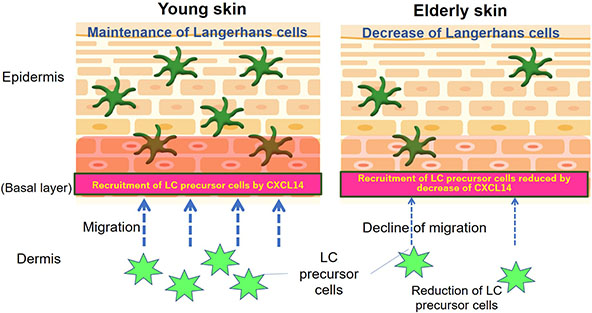
Mechanism of aged-related reduction of Langerhans cell suggested by this study.
ABOUT US
- Who we are
- History
- Profile
- Governance
- Quality Management
- Supply Network
- Region/Business
BRANDS
- Prestige
- Premium
- Inner Beauty
- Life Quality Makeup
SUSTAINABILITY
- Strategy / Management
- Society
- Environment
- Governance
- Reports / Data
- Related Information
INNOVATION
- Research and Development
- Research Areas
- Research outcomes
- Product safety
- Product Development Policy
- Initiatives for doctors and researchers
CAREERS
INVESTORS
- IR Library